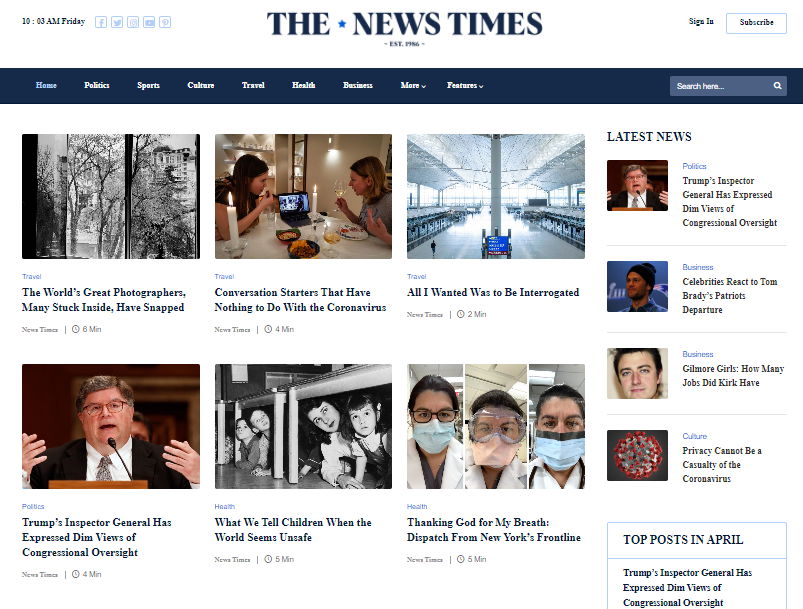How to Spot Credible Stories on stnews.live
Wiki Article
The Effect of Social Network heading We Take In News Online
Social network has basically transformed news usage. It provides prompt access to information, usually eclipsing conventional media outlets. This quick circulation comes with challenges. Individuals encounter the threat of encountering misinformation and coming to be trapped in resemble chambers. The formulas driving individualized content can obscure varied perspectives. As these dynamics advance, understanding their effects comes to be essential for notified engagement in public discussion. What strategies might assist navigate this facility landscape?The Evolution of News Intake in the Digital Age
As modern technology advanced, the method individuals consumed news transformed significantly in the digital age (stnews.live). Standard newspapers and relayed media started to decrease as the internet became a key source of info. Online systems used instant accessibility to newspaper article, videos, and podcasts, permitting customers to stay informed at any moment. The comfort of smart phones additionally accelerated this shift, making it possible for customers to receive updates on the goFurthermore, the surge of news collectors and internet sites facilitated the usage of varied viewpoints, empowering individuals to customize their news intake based upon personal interests. This evolution also triggered wire service to adapt their methods, focusing on digital content and engaging viewers with multimedia layouts. Therefore, the standard barriers of time and area in news shipment decreased, bring about an extra instant and tailored news experience for target markets worldwide.
The Duty of Social Network Operatings Systems in News Distribution
Social media site platforms have actually transformed news circulation by offering immediate accessibility to details. Their algorithm-driven web content curation usually focuses on engagement over precision, leading to significant reliability obstacles (stnews.live). As customers browse this landscape, the ramifications for news usage and public discourse ended up being progressively complexInstant News Accessibility
Standard news outlets have long been the primary source of details, the rise of social media systems has significantly transformed exactly how news is accessed and taken in. Instant news gain access to has actually come to be a characteristic of the digital age, allowing individuals to receive updates in real time. Platforms such as Twitter, Facebook, and Instagram allow news to spread swiftly, typically going beyond conventional media in speed and reach. Users can share tales, remark on events, and involve with journalists, producing a vibrant communication between the audience and news web content. This immediacy fosters a culture of urgency, triggering individuals to seek info quickly. Consequently, the expectation for timely news has improved journalistic techniques, compelling news companies to adapt their techniques to fulfill the demands of a fast-paced electronic atmosphere.Algorithm-Driven Web content
While users actively involve with content on social media sites, the formulas that regulate these systems play a crucial duty in identifying which news tales acquire exposure. These algorithms assess individual behavior, choices, and engagement metrics to curate personalized news feeds. Therefore, specific stories might be intensified while others continue to be odd, commonly prioritizing mind-blowing or trending subjects over substantive reporting. This discerning direct exposure shapes individuals' assumptions of present occasions and affects public discourse. The reliance on algorithm-driven web content can create echo chambers, where customers are mostly exposed to point of views that line up with their own beliefs. Subsequently, the characteristics of news circulation on social networks platforms significantly impact how individuals take in and analyze info in the electronic age.
Trustworthiness Obstacles
As customers progressively transform to social networks for news, the credibility of info encountered on these systems ends up being a pressing issue. The decentralized nature of social networks allows anyone to publish content, often blurring the lines in between reliable journalism and false information. Algorithms prioritize engagement over accuracy, resulting in the widespread dissemination of marvelous or misleading tales. This setting presents substantial difficulties for individuals trying to discern trustworthy resources. Social media platforms, while striving to fight false information through fact-checking and web content moderation, run the gauntlet for inconsistencies and biases in their methods. Eventually, the responsibility exists with individuals to critically assess the news they consume, as the fast spread of info commonly outmatches confirmation efforts by platforms.The Increase of Resident Journalism and User-Generated Material
The rise of citizen journalism has encouraged daily individuals to share news and point of views, frequently supplying insights that traditional media might ignore. This change additionally provides substantial difficulties, especially the spread of misinformation that can arise from unverified content. As user-generated material ends up being a lot more common, the balance in between authentic voices and precision in reporting stays a crucial concern.Encouraging Daily Voices

Obstacles of False information
While the rise of resident journalism has actually opened up opportunities for diverse voices in the media landscape, it has actually also introduced substantial challenges associated with misinformation. The simplicity of sharing information with social media sites systems allows individuals to distribute news quickly, yet this fast spread frequently comes at the price of precision. User-generated material frequently lacks the extensive fact-checking and content oversight that typical journalism offers. As a result, sensationalized or incorrect narratives can acquire traction, deceiving audiences and shaping public understanding (stnews.live). The mixing of point of view and reality within social media complicates the difference between reliable info and false information. Consequently, customers must browse an increasingly complicated media environment, needing essential assuming abilities to discern reputable news resources among the sound
Misinformation and Its Implications for Public Discussion
As social media sites systems progressively control the landscape of details circulation, the spreading of misinformation postures substantial difficulties for public discourse. False information, often developed to deceive or provoke psychological feedbacks, can distort understandings of reality and threaten count on trustworthy resources. This phenomenon leads to polarized point of views, as individuals gravitate in the direction of resemble chambers that reinforce their beliefs, better setting departments within culture.The effects for public discussion are extensive. When citizens depend on incorrect information, meaningful dialogue diminishes, and the autonomous procedure suffers. Misinformation can provoke concern and complication, influencing public wellness, safety and security, and political security. As an outcome, cultivating media proficiency becomes important, empowering people to seriously review details and discern truth from fiction. Resolving the difficulties positioned by false information is crucial for preserving the honesty of public discourse and making sure a well-informed populace with the ability of taking part in constructive discussions.
The Influence of Formulas on News Visibility
Offered the main role of algorithms in figuring out content exposure, their impact anonymous on news consumption is profound. These formulas, utilized by social media sites platforms, focus on particular kinds of material based on user involvement and preferences. Because of this, news posts that line up with preferred trends or target market passions are more probable to be shown plainly, while much less thrilling tales may be neglected. This produces an environment where customers are revealed mainly to details that strengthens their perspectives, possibly resulting in echo chambers.In addition, the consistent development of algorithms suggests that news organizations should adjust their strategies to line up with these transforming specifications, often focusing on clickbait or psychologically billed headings. The stability of news reporting can be compromised, as critical stories may not obtain the visibility they should have. The algorithmic shaping of news presence consequently plays an important duty in influencing public perception and understanding of existing events.
The Change Towards Aesthetic Storytelling in News Media
Significantly, news media is welcoming aesthetic narration as a powerful device to engage target markets. This strategy leverages images, videos, infographics, and interactive aspects to communicate information better than typical text-based styles. As attention extends shorten, visuals supply a quick, impactful means to interact complex stories and get hold of visitors' interest.Platforms like Instagram and TikTok have more increased this fad, compelling wire service to adapt their material methods to fit these visually-driven settings. By integrating engaging visuals, news outlets can improve emotional connections and foster higher understanding of topical issues.
Aesthetic storytelling enables for more varied narratives, showcasing multiple point of views with dynamic discussions. As target markets progressively take in news with mobile tools, the change toward visuals not just provides to user choices but likewise assists to damage down barriers to information accessibility. Eventually, this advancement mirrors a broader improvement in exactly how news is produced and eaten in the electronic age.
Future Fads: Navigating the Altering Landscape of News Intake
While the electronic landscape continues to evolve, news intake is positioned for considerable transformation driven by arising innovations and transforming audience actions. As expert system and device learning development, customized news feeds will certainly become much more widespread, permitting customers to get material tailored to their rate of interests. This modification can bring about better involvement however likewise increase concerns regarding echo chambers and misinformation.Moreover, the rise of voice-activated tools and smart speakers will influence exactly how news is provided, shifting the emphasis from visual to auditory Resources layouts. This fad might motivate news companies to take on more succinct and interesting audio web content.

Regularly Asked Questions
Exactly How Do Social Network Communications Affect News Integrity?
Social network interactions can greatly affect perceptions of news credibility. Engagement metrics, such as likes and shares, commonly form target market trust, with preferred articles obtaining regarded legitimacy, no matter the precision or dependability of the info presented.What Role Do Influencers Play in Shaping News Narratives?
Influencers greatly shape news narratives by leveraging their systems to amplify specific tales, usually tailoring web content to their audience. This can result in prejudiced perspectives, impacting public assumption and focusing on sensationalism over accurate coverage.How Can Users Identify Reliable News Resources on Social Media Site?
Users can recognize trusted news resources on social networks by inspecting the source's credibility, validating truths with multiple outlets, reviewing the expertise of the material, and identifying possible prejudices in reporting to guarantee exact info.What Impact Does Social Network Carry Conventional Journalism Jobs?
Social network significantly affects typical journalism jobs by changing income models, lowering need for print media, and promoting competitors from resident reporters. Lots of professionals deal with task insecurity and need to adapt to rapidly transforming media landscapes.Exactly How Do Different Demographics Consume News on Social Network?
Different demographics show diverse choices for news usage on social networks. More my link youthful audiences favor platforms like TikTok and Instagram for fast updates, while older people have a tendency to favor Twitter and facebook for more comprehensive conversations and posts.Report this wiki page